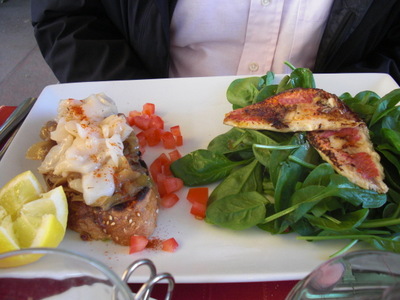
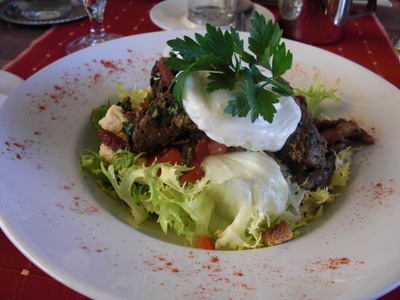 We settled at the Brasserie La Malarte, conveniently near the parking lot.
We settled at the Brasserie La Malarte, conveniently near the parking lot.Sunday, 26 May 2013: Farewell to CJ and Jeff
Written Wednesday, 12 June 2013
Sunday morning we got up earlier than we had been and got on the road at 9:30 a.m., so as to be able to drop CJ and Jeff at the Marseille airport at 11:00 a.m. before their 1:30 p.m. flight. The drive down through the fringes of the Camargue, which we'd made once before, from Arles, to pick them up, was just as beautiful, but we were all rather subdued during the trip. We were at least able to show them flamingos, rice paddies, salt pans, and even some Camargue bulls before being plunged into the nightmare freeway tangle near the airport. We got them there in plenty of time but were very sad to see them go.
From there, we just turned around and drove back to Nîmes. By lunch time, David was getting pretty tired of driving (he hadn't slept well and found the early start difficult), so we stopped in Arles for lunch, where we already knew the traffic pattern and where to park.

 We settled at the Brasserie La Malarte, conveniently near the parking lot.
We settled at the Brasserie La Malarte, conveniently near the parking lot.
David had a main course that was billed as a "spinach salad," but as you can see, it included a grilled fillet of rouget and a slab of toast spread with caramelized onions and topped with raw marinated scallops.
I ordered two starters: a "poultry yard" salad with chicken livers and gizzards and a poached egg and "soupe au pistou" (not shown), sort of the Provençal version of a meatless minestrone with a big spoonful of pesto added at serving time.
After lunch, to stretch our legs, we strolled around the old town, and David got to see the Place du Forum, which he'd missed the first time.
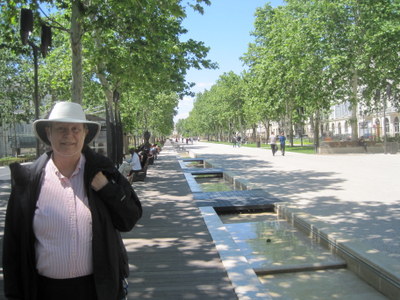
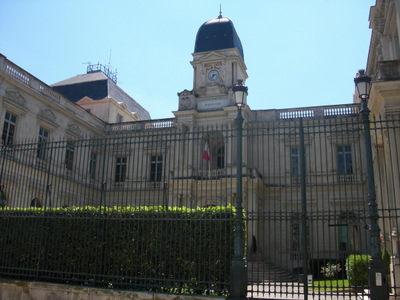 After the short drive back to Arles (and hitting the right parking garage the first time), we set out to explore the old town. From our hotel, we walked through the train station and up this splended pedestrian boulevard, which connected the station with the old center of the city. The watercourse down one side of it represents the river that used to flow through and is now mostly underground. This section happened to be turned off when David took the photo, but when all the sections are flowing, it makes a nice series of little waterfalls all the way down to a reflecting pool with intermittent fountains just in front of the station (behind David as he took this picture).
After the short drive back to Arles (and hitting the right parking garage the first time), we set out to explore the old town. From our hotel, we walked through the train station and up this splended pedestrian boulevard, which connected the station with the old center of the city. The watercourse down one side of it represents the river that used to flow through and is now mostly underground. This section happened to be turned off when David took the photo, but when all the sections are flowing, it makes a nice series of little waterfalls all the way down to a reflecting pool with intermittent fountains just in front of the station (behind David as he took this picture).
Partway up the boulevard, on the left, was the imposing Prefecture of Gard, Nîmes's département, shown here on the right. French départements tend to be named after their rivers, and the Gard (or Gardon) is the river spanned by the Pont du Gard.
At the top of the boulevard, and about a block to the left, is the Arène de Nîmes, the Roman amphitheater. We got that far, but David decided his feet were not up for the duration fo the audioguided tour, so we put it off until the next day and he went back to the hotel to take a nap while I continued exploring.
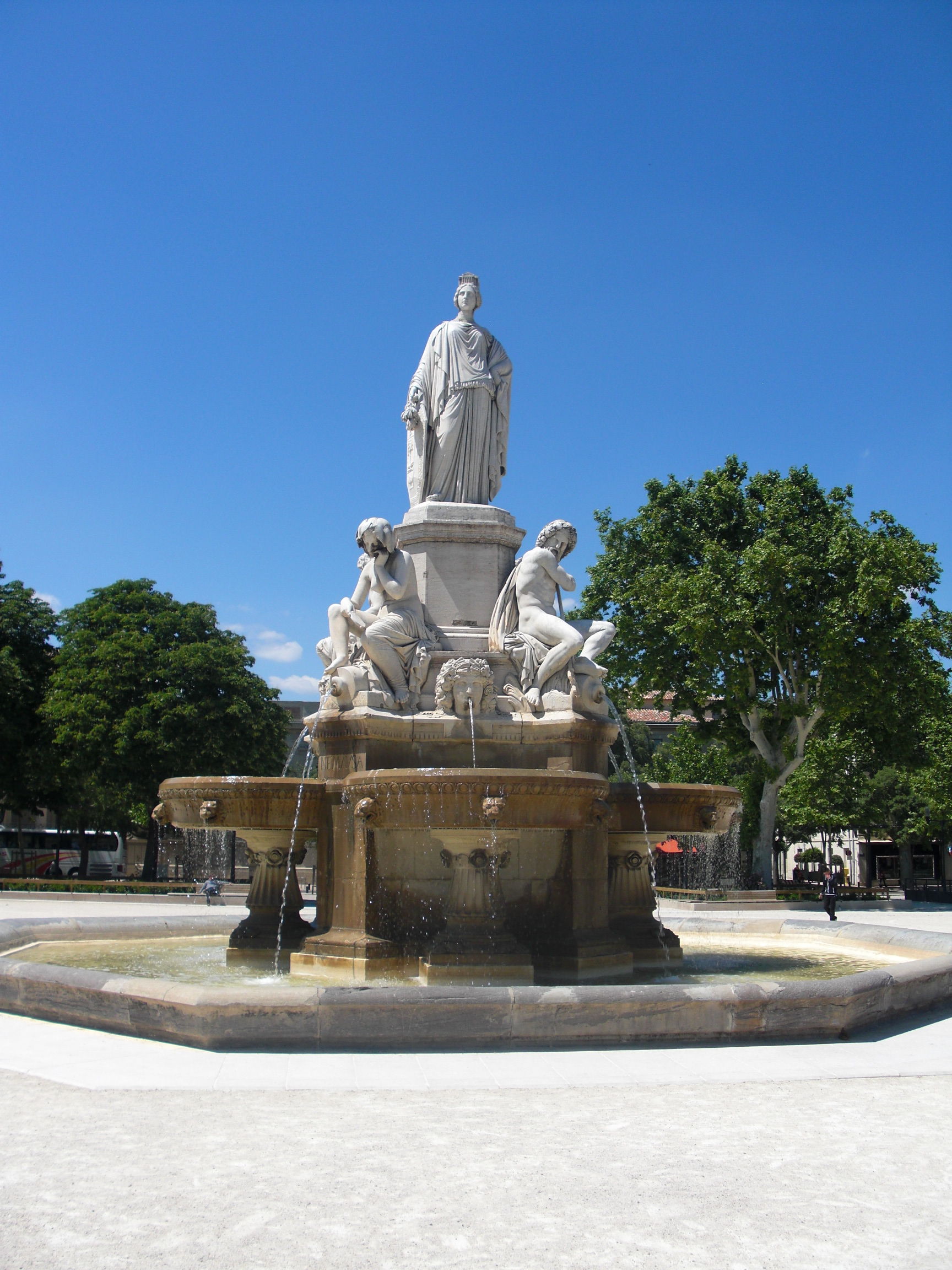
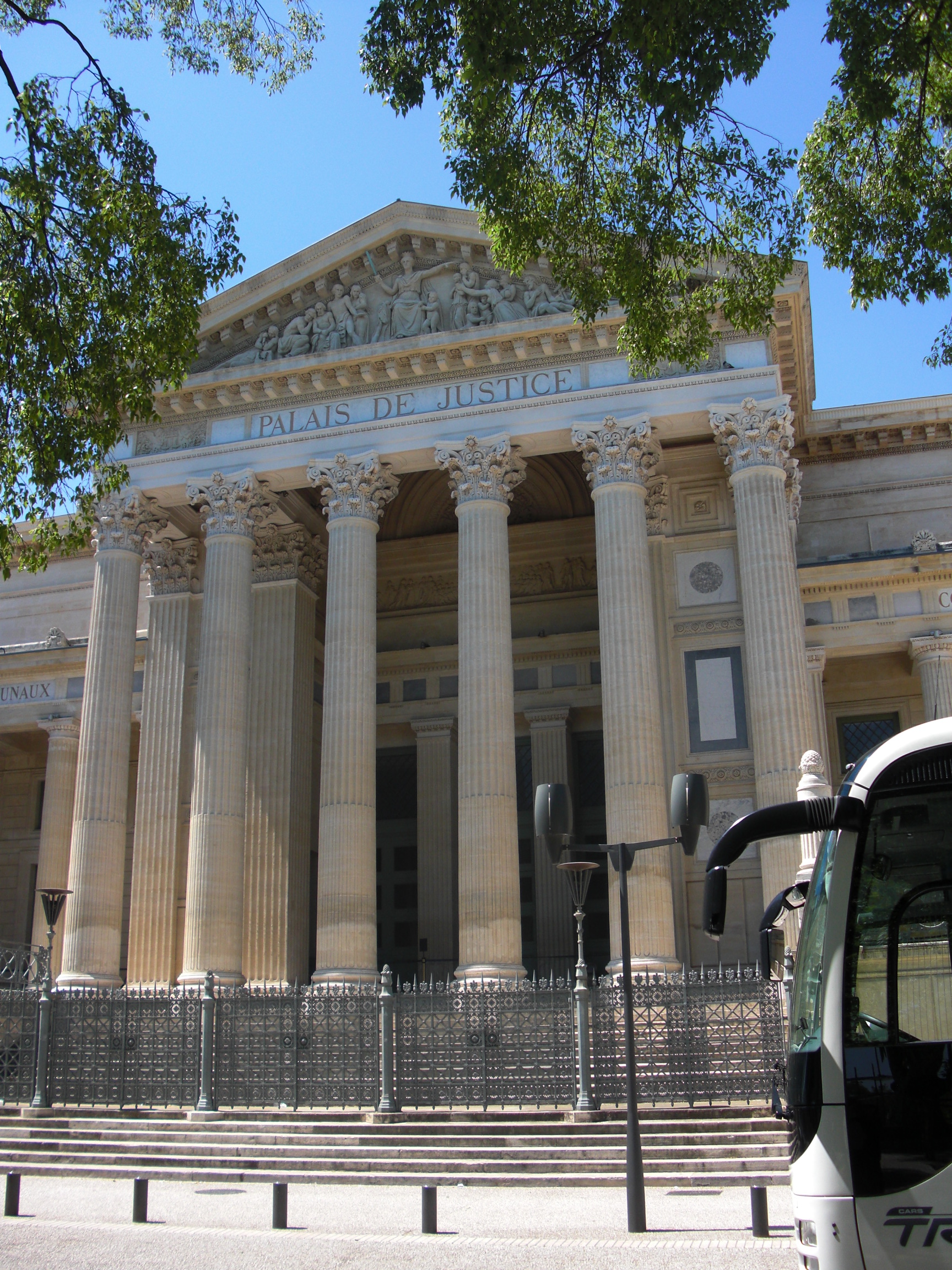
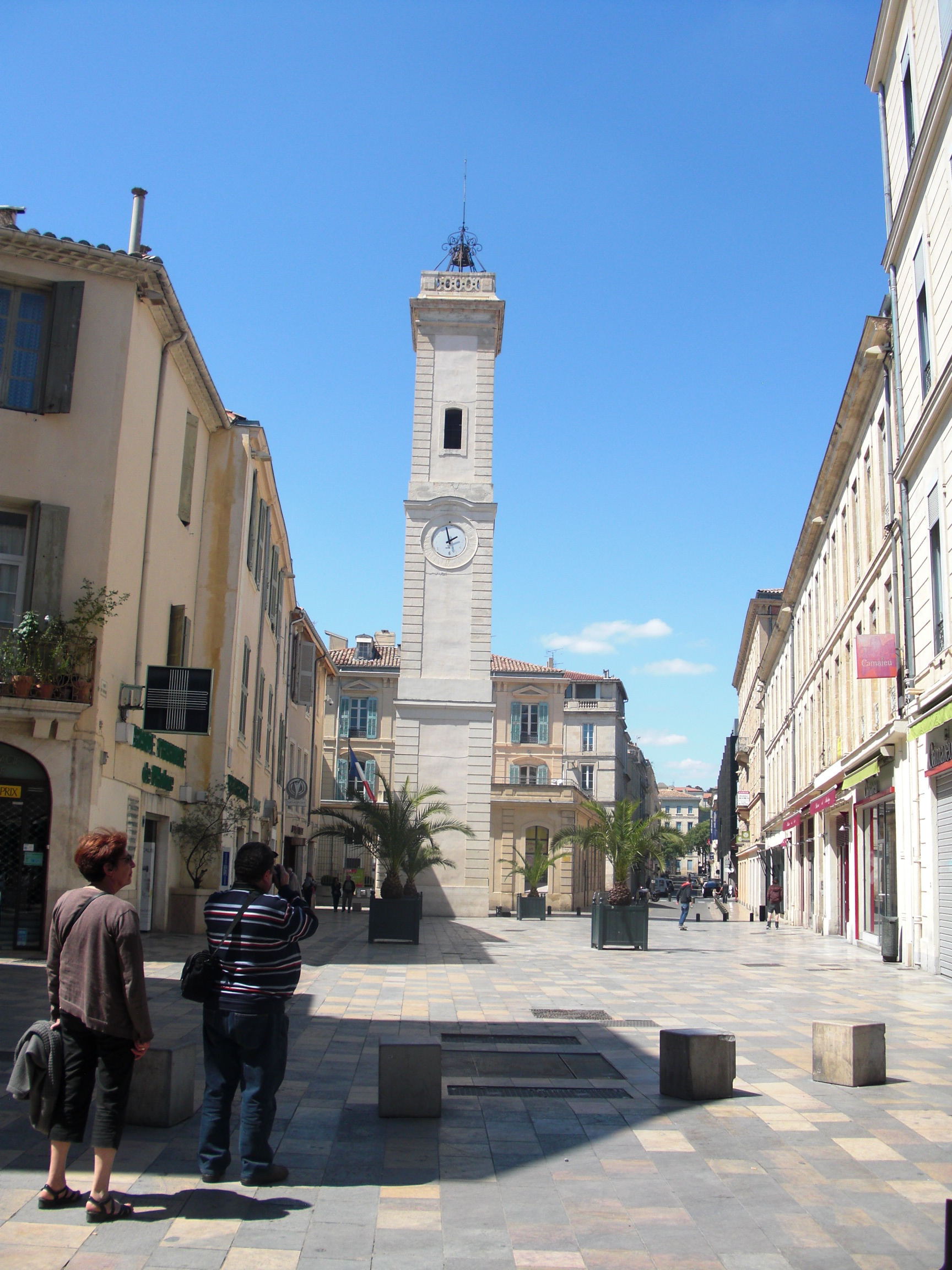 At the top of the boulevard, facing down toward the station, is a statue (above, left) representing4the city of Nîmes. Around her feet are figures representing the four rivers of the département, and at their feet are heads spouting fountains into the basin below.
At the top of the boulevard, facing down toward the station, is a statue (above, left) representing4the city of Nîmes. Around her feet are figures representing the four rivers of the département, and at their feet are heads spouting fountains into the basin below.
Behind the statue, also facing down the boulevard, is the Palais de Justice (above, center). It's quite wide and very imposing, but to get close enough to photograph it behind its screen of trees, I had to narrow the shot to just its "front porch," with marble columns.
A few blocks into the old town, in the Place du Clocher, is the clock and bell tower (above, right).
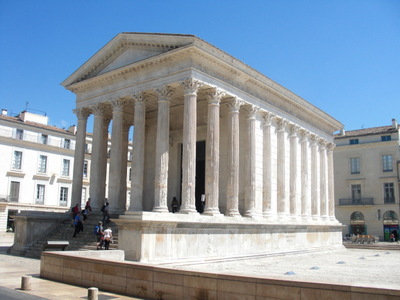
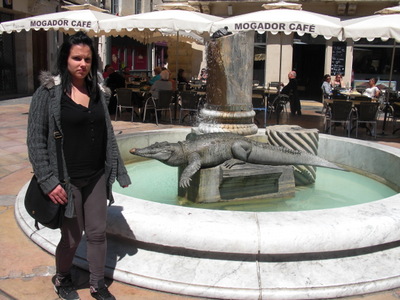 In the northwest area of the old city is the Maison Carré (left; literally, the Square House), a very well preserved Roman temple that once housed the prefecture but is now just a monument. Inside they show a film about the city.
In the northwest area of the old city is the Maison Carré (left; literally, the Square House), a very well preserved Roman temple that once housed the prefecture but is now just a monument. Inside they show a film about the city.
And in the center of the old city, in the Place du Marché, was this remarkably lifelike bronze crocodile roped and chained to a broken column (the top of which is a tiny fountain much enjoyed by the pigeons and other birds). Note how smooth and shiny his nose is, because of all the tourists who lean over to pet him for photos (the nose is the only part you can reach without stepping into the fountain). Now I had already noticed the crocodile all over town. The sidewalks were studded with little medallions of crocodiles chained to palm trees. Wherever posts had been set up to exclude vehicles from pedestrian streets, their tops bore larger medallions of the same image. Bronze crocodiles hang from the ceiling in the Hôtel de Ville. What was it with the crocodiles?!
Long story: Back in 31 B.C., Octavian (who would later be known as Augustus Caesar) fought and won the battle of Actium (against the forces of Mark Antony and Cleopatra) and thereby solidified definitively the Roman domination of the Med and of Egypt. Nîmes (then known as Nemausus) was the site of a major mint, which produced a bronze coin commemorating the occasion. "Heads" showed Octavian and his son-in-law Agrippa, and "tails" featured a crocodile chained to a palm tree surmounted by a laurel wreath, symbolizing Rome's new domination of Egypt; it also showed the words "col nem," for "Colony of Nemausus." The coin was very popular, was restruck several times, and became very common and widespread, and especially so around Nîmes. Centuries later, long after they were no longer legal tender, those coins tended to turn up everywhere in the area, anytime somebody dug a ditch or cleaned out a cellar.
Nˆmes had had several official seals in its history, but on the occasion of a visit from François I in 1536, the city asked permission to adopt that image of the crocodile and the palm tree as its emblem. The request was granted, and it's been all crocodiles all the time ever since. The image was redesigned and modernized in 1985, and the new one is what you most often see now. I don't know the date of the fountain, but they have surely had to replant the palm tree at the other end of the square several times since the 16th century.
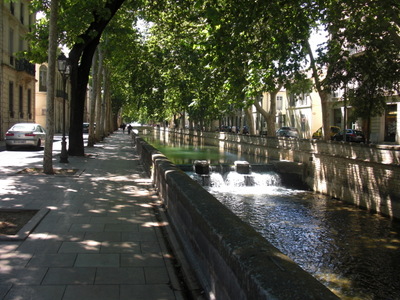
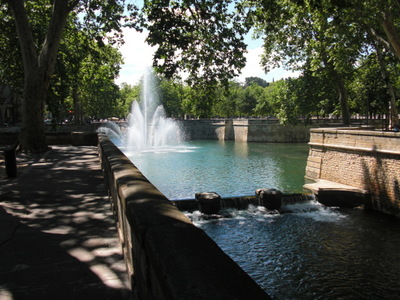 Looking, from the edge of the old city, along a shady side street with a canal down its median, I spotted a distant fountain, surely the same one that lured Jeff and CJ, and headed that way. At the far end of the canal, I found not just the fountain but a large and beautiful park (built, I learned later, on the site of a large "sanctuary" to the cult of the emperor) that included shady allées, sunny squares, all the requisite crèpe and ice cream vendors, and pony rides for little kids. The rides were definitely better than the ones at the state fairs of my youth. Those ponies were tied to a circular apparatus that made them plod round and round in a tight circle. These were not so constrained. Paying the fee entitled the rider to circle a whole section of the park with an adult leading the pony. Parents who felt up to it could lead the ponies themselves; those who didn't were accompanied by a handler.
Looking, from the edge of the old city, along a shady side street with a canal down its median, I spotted a distant fountain, surely the same one that lured Jeff and CJ, and headed that way. At the far end of the canal, I found not just the fountain but a large and beautiful park (built, I learned later, on the site of a large "sanctuary" to the cult of the emperor) that included shady allées, sunny squares, all the requisite crèpe and ice cream vendors, and pony rides for little kids. The rides were definitely better than the ones at the state fairs of my youth. Those ponies were tied to a circular apparatus that made them plod round and round in a tight circle. These were not so constrained. Paying the fee entitled the rider to circle a whole section of the park with an adult leading the pony. Parents who felt up to it could lead the ponies themselves; those who didn't were accompanied by a handler.
The park, the first public park in France, was crisscrossed by canals full of carp and goldfish, and I spotted several kinds of ducks—not many—just one pair of wood ducks, a couple of pairs of mallards, and that purple-headed European duck we saw in the Camargue. In a section largely set off from the rest by canals, several games of pétanque were going on (as they always are, 24 hours a day, 365 days a year, in any French park).
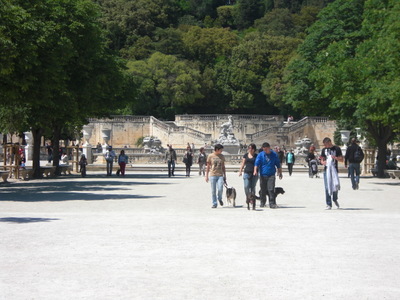
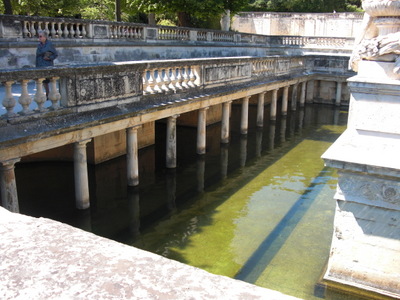 At the back of the park, against a hill, was this ornate belvedere. It looks fairly flat in this distant photo, but as you approached the first stone railings, you found that they surrounded sunken pools, again stocked with ornamental fish.
At the back of the park, against a hill, was this ornate belvedere. It looks fairly flat in this distant photo, but as you approached the first stone railings, you found that they surrounded sunken pools, again stocked with ornamental fish.
The architect originally envisioned layer upon layer of terraces and belvederes all the way up the hillside to the ruined Roman tower at the top, but that plan was abandoned. Now the hillside is an ornamental garden with walking paths, some of which lead to the tower. Given more time, I would have liked to make the climb.
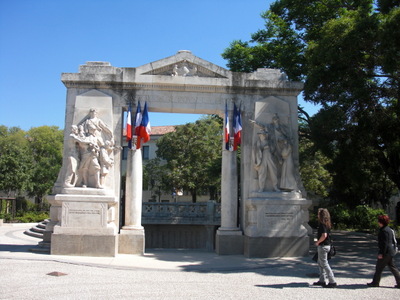
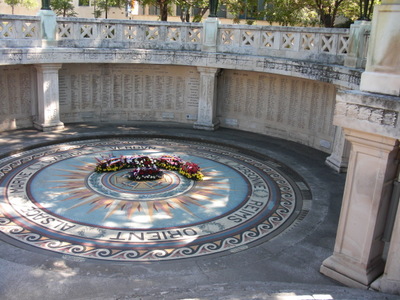 On the way back toward the hotel, I came upon this handsome war memorial, also one of the features of the large plaza at the top of the pedestrian boulevard. It's less conspicuous to a walker coming up from the station, but coming back this way, its gate stands out.
On the way back toward the hotel, I came upon this handsome war memorial, also one of the features of the large plaza at the top of the pedestrian boulevard. It's less conspicuous to a walker coming up from the station, but coming back this way, its gate stands out.
Inside the gate, which is closed at night by an ornamental iron grill, is this round, sunken chamber with a mosaic floor listing the names of major battles. The names of the fallen are engraved on the walls, and above them, just below the stone balustrade, are the words "To the children of Nîmes and of the Gard who died for France." When the gates are open, one can walk down steps to read the names, but I was running out of time.
When I got back to the hotel, weary and footsore, I found the elevator out of service. Fortunately, the receptionist took me around the back and let me ride the service elevator, so I didn't have to climb to the fifth floor. Definitely not the best Ibis Budget around. I figured we would have to walk down the stairs to dinner, but surprisingly, the elevator was working again by the time we went out—I never thought they'd be able to get it worked on on Sunday.
Nîmes pretty much shuts down on Sunday nights, but we found dinner at La Grande Bourse, right across the street from the arènes. It was clearly a fairly dressy place under that name at one time, but it must have fallen on hard times before being acquired by the Brasserie Flo chain. Unfortunately, it didn't live up to that chain's usually high standards. It has several different entrances, with different names over the doors. We wound up in the section called "Le Petit Bofinger." Bofinger is a beautiful old Alsatian brasserie in the Place de la Bastille in Paris. We've eaten there many times, both before and after it joined the Brasserie Flo group. (Brasserie Flo is the name of the original establishment in the chain, which is owned and managed as a labor of love by a Paris restaurateur who acquires and carefully restores cafés and brasseries from the Art Nouveau and Art Deco eras. The food and service are normally excellent.) The group has opened a couple of "Petit Bofingers" in Paris, but this was the first one we'd encountered elsewhere.
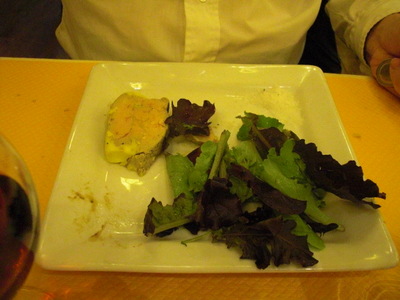
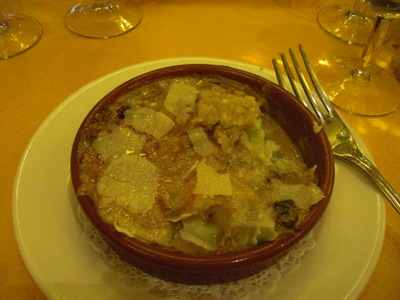 First course, David: Cold foie gras with a small salad. Perfectly good, but nothing out of the ordinary.
First course, David: Cold foie gras with a small salad. Perfectly good, but nothing out of the ordinary.
First course, me: Ravioli de Royans with cêpes (i.e., porcini, Boletus mushrooms). The name rang a bell, but I couldnt remember what made Royans ravioli different. I was soon reminded. I remember these—delicious tiny ravioli filled with a green-onion mixture, then baked in a cream and cheese sauce, this time with cêpes in a round pottery crock. They were outstanding; definitely the best dish of the meal.
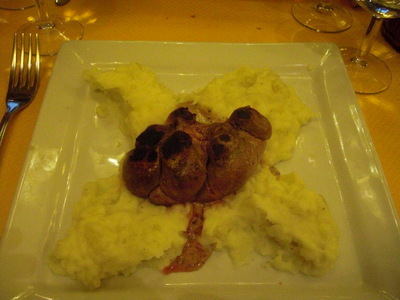
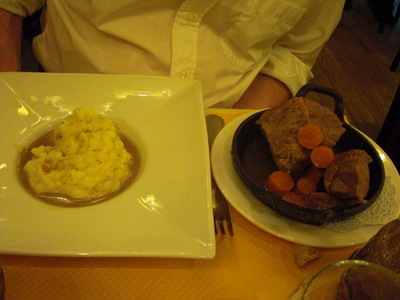 Main course, David: Seven-hour lamb with mashed potatoes. This dish is usually a sort of pot roast of lamb, served in a thick gravy with vegetables. This one was naked chunks of lamb and cooked carrots, fished out of whatever broth they were cooked in. Tender enough but not as succulent as it should have been. The potatoes were topped with a thin gravy with coarse mustard in it.
Main course, David: Seven-hour lamb with mashed potatoes. This dish is usually a sort of pot roast of lamb, served in a thick gravy with vegetables. This one was naked chunks of lamb and cooked carrots, fished out of whatever broth they were cooked in. Tender enough but not as succulent as it should have been. The potatoes were topped with a thin gravy with coarse mustard in it.
Main course, me: Veal kidneys, also with mashed potato. I'd asked to have them cooked "rosy," and inside, they were, but the top surface was not just tough but scorched hard and black. I sliced that part off, then ate what I could of the interior, but they hadn't been trimmed of their interior tendons, so that part was pretty hard to cut. Not stellar.
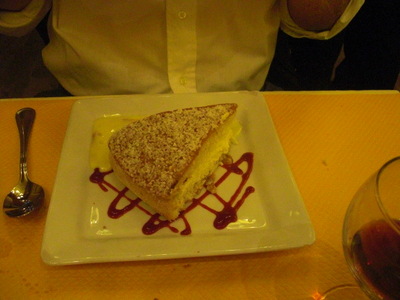
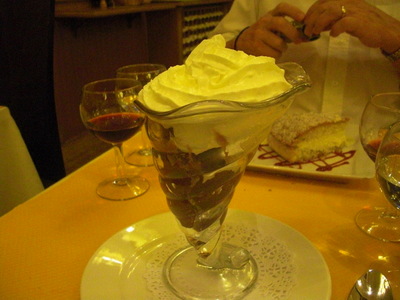 Dessert, David: Pastry of the day, which turned out to be a slice from a round loaf of brioche split and stuffed with pastry cream and sprinkled with coarse sugar. He said it was pretty good.
Dessert, David: Pastry of the day, which turned out to be a slice from a round loaf of brioche split and stuffed with pastry cream and sprinkled with coarse sugar. He said it was pretty good.
Dessert, me: Coupe Cévenole, vanilla ice cream topped with sweetened chestnut cream from a named supplier and whipped cream. The chestnut cream was better than any I'd ever had, very smooth.
Not a meal I would have expected to get at a Petit Bofinger. The service was disorganized, but our individual waiter was good, and when we discovered on the way home that David had dropped his camera and went back, he had it waiting for us.